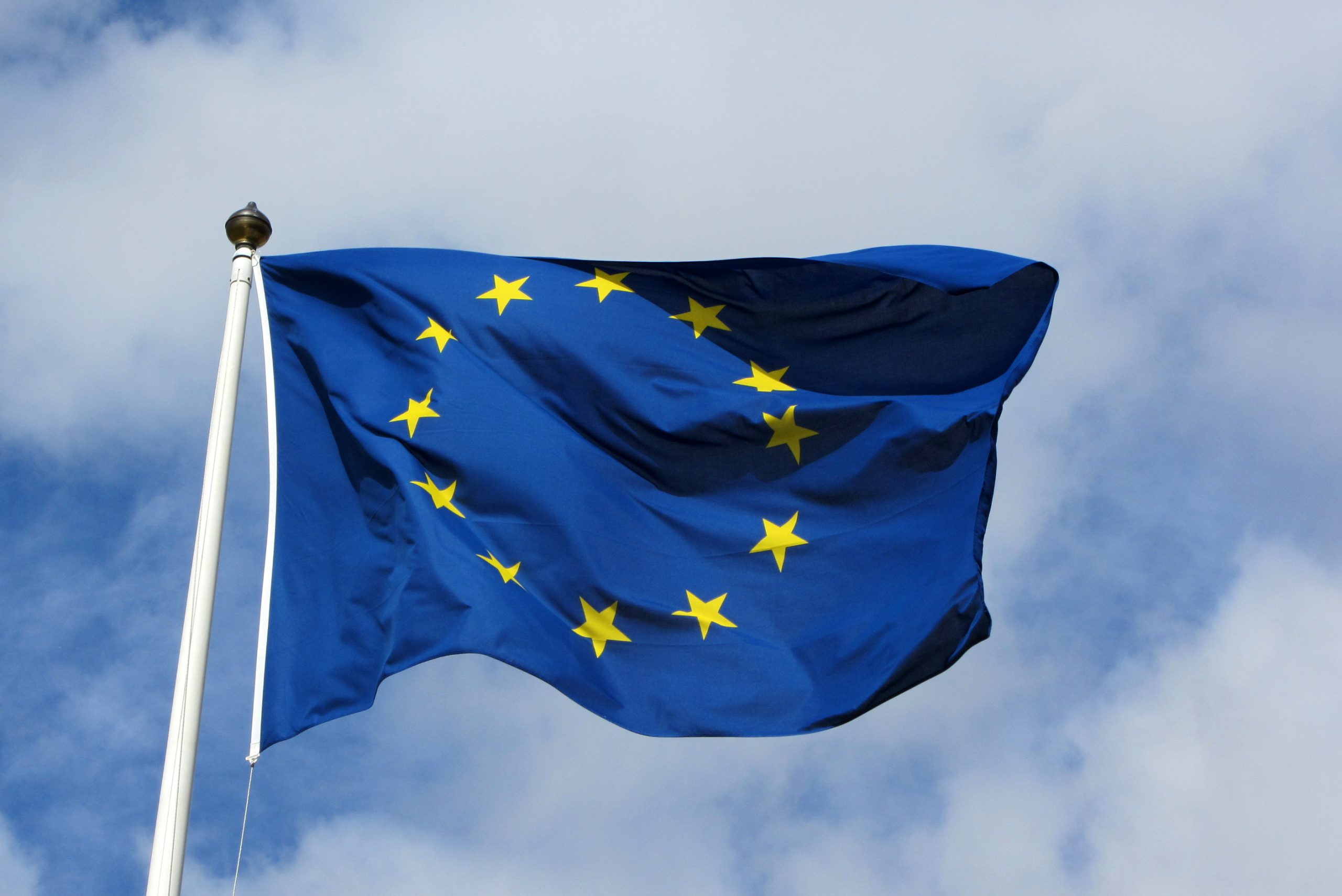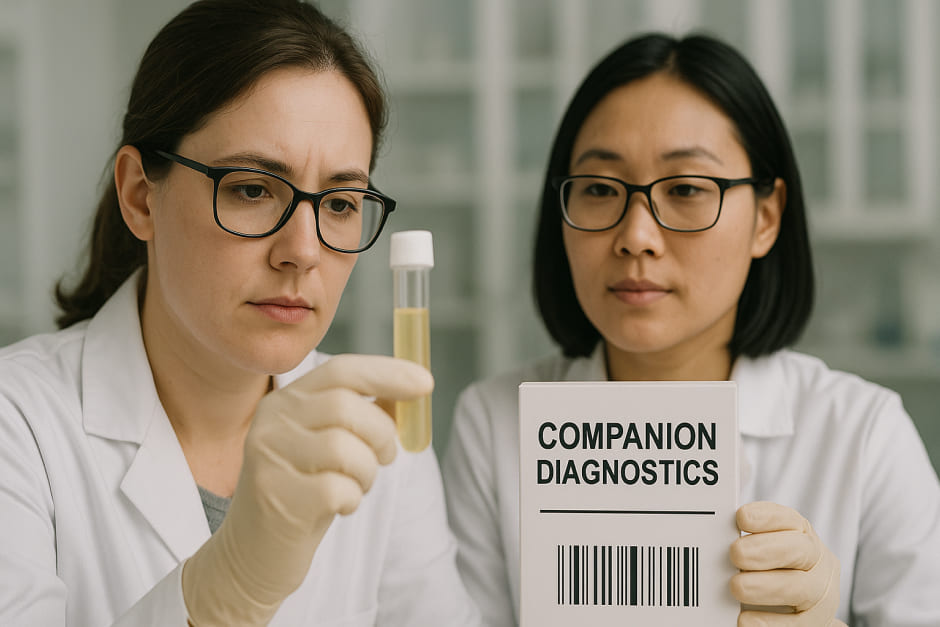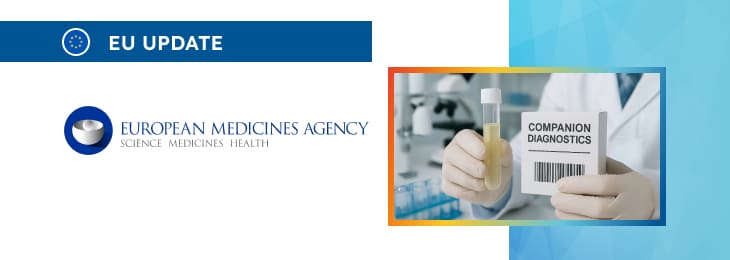The article provides a brief overview of a consolation document intended to address the key points related to companion diagnostics in the context of the current EU regulatory framework.

Table of content
The European Medicines Agency (EMA) has published a questions-and-answers document dedicated to the practical arrangements on the companion diagnostics consultation procedure. The document provides additional details on the most important questions the industry might have with respect to the matter, as well as general clarifications and recommendations to be taken into consideration by the parties involved in order to ensure compliance with the relevant regulatory requirements.
Submission of the Letter of Intent for an Initial Consultation
According to the document, applicants intending to initiate a consultation procedure with the European Medicines Agency regarding a companion diagnostic are required to submit a “letter of intent” at least three months prior to the expected application submission date.
As explained by the authority, this notification is crucial to enable timely planning and resource allocation within the EMA. The “letter of intent” must be submitted by raising a ticket through the EMA Service Desk. Specifically, applicants should select the “Business Services” tab, the category “Human Regulatory,” and then the sub-option “Pre-Submission Phase – Human” followed by “Companion Diagnostics Request.”
In accordance with the relevant administrative arrangements, applicants must not send any documents directly to individual email addresses within the Agency. Furthermore, if the applicant does not yet possess an EMA Account, the document instructs that one should be created through the EMA Account Management portal, following the detailed guidance available under “Create an EMA Account.”
A standard template for the intention-to-submit letter is also provided by the Agency on the EMA webpage dedicated to companion diagnostics (CDx).

Notification of Changes
In the event of a change in either the designated contact person or the intended submission date initially indicated, the document specifies that the applicant must promptly inform the EMA.
This should be accomplished, again, by raising a ticket via the EMA Service Desk, selecting “Business Services,” under the category “Human Regulatory,” and then the subcategory “Pre-Submission Phase – Human” followed by the option “Notification of Change Request.”
The EMA underscores that having an active EMA Account remains a prerequisite for such communications, ensuring traceability and proper documentation in line with internal procedural requirements.
Appointment of the Rapporteur
Following the receipt of the letter of intent, the document states that the EMA will initiate the appointment process for a Rapporteur, through the involvement of the Committee for Medicinal Products for Human Use (CHMP) and, where applicable, the Committee for Advanced Therapies (CAT).
As clarified by the Agency, the applicant will be informed of the outcome of the Rapporteur appointment. This early designation ensures that responsibility for scientific evaluation is clearly assigned from the outset of the consultation process.
EMA Contact Person during the Consultation
According to the practical guidance provided, the primary contact person at EMA for applicants throughout the companion diagnostic consultation procedure is the Product Lead (PL).
The PL is assigned after submission of the letter of intent and confirmation of the EMA product number. As explained by the EMA, the PL will act as the principal liaison between the Rapporteurs and the applicant, ensuring that the applicant is adequately informed at every step.
In accordance with the operational expectations outlined in the document, the PL will assist with:
- Validation issues during the consultation procedure
- Procedural and regulatory queries prior to and during the evaluation
- Provision of assessment reports and scientific opinions
- Discussion and confirmation of timetables
- Guidance on all evaluation-related matters
The EMA emphasizes that all communications concerning the companion diagnostic consultation must be directed exclusively through the assigned PL.
Pre-Submission Interactions with the Rapporteurs
The document encourages early and proactive interactions between the relevant notified body, the device manufacturer, and the marketing authorisation holder(s) or applicant(s) for the associated medicinal products.
According to the described procedure, after receipt of the intention letter and up to two months before the intended application submission date, the notified body may submit questions regarding timing, regulatory or procedural issues directly to the PL.
These queries, as explained by the EMA, will be answered in writing. Furthermore, if more detailed guidance is required, a pre-submission meeting can be requested. Such meetings typically involve the participation of the PL, the Rapporteur, the device manufacturer, and the marketing authorisation holder(s)/applicant(s), and are intended to resolve complex issues prior to formal submission.
Submission of the Initial Consultation Application
In accordance with the current technical regulations, applicants are required to submit their initial consultation applications through the eSubmission Gateway or the eSubmission Web Client.
These electronic submission channels, as mandated by the authority, are the exclusive means for delivering documents to the EMA, ensuring security, traceability, and uniformity.
The document further highlights that applicants must:
- Register for the eSubmission Gateway and Web Client well in advance of the intended submission date (allowing up to 20 days for account activation).
- Ensure that all relevant submission attributes are completed through the eSubmission delivery file.
- Avoid sending additional copies directly to National Competent Authorities (NCAs) or via alternative platforms like CESP, to prevent validation issues or procedural delays.
Specific technical guidance documents are available for applicants to ensure proper formatting and submission compliance, including detailed manuals on XML delivery file preparation.
Moreover, all submissions sent through the Gateway/Web Client are considered delivered not only to the EMA but also to all NCA representatives, alternates, and experts engaged in the evaluation process.
Coordination with the Medicinal Product Evaluation
According to the practical arrangements outlined, the companion diagnostic consultation should ideally be submitted during the final evaluation phase of the associated medicinal product’s Marketing Authorisation Application (MAA).
The notified body and device manufacturer are strongly advised to maintain close communication with the medicinal product applicant/MAH to align timelines, particularly when the MAA approaches the opinion stage.
Such coordination is essential, as emphasized by the EMA, to ensure that evaluations proceed in parallel and that the companion diagnostic consultation integrates smoothly into the overall regulatory assessment process.
Specific procedural timetables, including those related to companion diagnostics, are published and maintained on the EMA website for reference.
Fees and Payment Procedures
As explained by the authority, applicants should refer to the Annex IV, Section 7.3 of the “Fees payable to the European Medicines Agency” for comprehensive information regarding fees applicable to companion diagnostic consultation procedures.
In accordance with the EMA’s financial rules, although the notified body submits the consultation request, it is the responsibility of the medical device manufacturer to pay the corresponding fees directly to the Agency.
The document specifies that manufacturers must request a customer account number from EMA’s Accounts Receivable service sufficiently in advance of submission deadlines.
This customer account number must be provided at the time of application to facilitate proper invoicing and payment tracking.
Manufacturers with official SME status, as registered with the EMA’s SME office, may benefit from fee reductions for scientific services, including the companion diagnostic consultation.
The relevant eligibility criteria and procedures are detailed in the EMA’s “SME User Guide for Micro, Small and Medium–Sized Enterprises.”
This initiative, according to the EMA, is intended to support innovation and regulatory compliance among smaller businesses operating in the medical devices sector.
Conclusion
In summary, the document “Questions & Answers – Practical Arrangements on the Companion Diagnostics Consultation Procedure to the EMA by Notified Bodies” provides a detailed operational framework governing how notified bodies and device manufacturers must interact with the EMA when seeking a consultation on companion diagnostics.
How Can RegDesk Help?
RegDesk is an AI-powered Regulatory Information Management System (RIMS) designed to simplify global compliance for medical device companies. With regulatory intelligence covering 120+ markets, RegDesk helps you prepare and publish global submissions, manage standards, conduct impact assessments, and stay ahead of regulatory changes all from a single, centralized platform. Expanding into new markets has never been easier.

